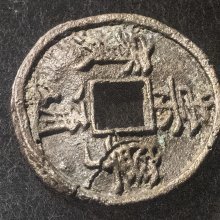Kalaya, Kālāya, Kalāya: 18 definitions
Introduction:
Kalaya means something in Hinduism, Sanskrit, Jainism, Prakrit, Buddhism, Pali, the history of ancient India, Marathi, biology. If you want to know the exact meaning, history, etymology or English translation of this term then check out the descriptions on this page. Add your comment or reference to a book if you want to contribute to this summary article.
Images (photo gallery)
(+3 more images available)
In Hinduism
Ayurveda (science of life)
Dietetics and Culinary Art (such as household cooking)
Source: Shodhganga: Dietetics and culinary art in ancient and medieval IndiaKalāya (कलाय) refers to “peas”, according to the Carakasaṃhitā Cikitsāsthāna 20.37, and is commonly found in literature dealing with the topics of dietetics and culinary art, also known as Pākaśāstra or Pākakalā.—According to Carakasaṃhitā, pulses such as mudga (green gram), masūra (lentil), caṇaka (hemp) and kalāya (pea) were parched and eaten. Parpaṭas were prepared with flour of pulses. The soup prepared from mudga is described in Suśrutasaṃhitā.
Kalāya or “field pea” is classified as a type of grain (dhānya) in the section on śimbīdhānya (grains with pods) in the Bhojanakutūhala (dravyaguṇāguṇa-kathana).—In śimbīdhānya-prakaraṇa the properties of grains with pods such as mudga (green gram), māṣa (black-gram), caṇaka (bengal gram), kalāya (field pea), tila (sesame), atasī (linseed), sarṣapa (mustard) and masūra (lentils) are explained.
Unclassified Ayurveda definitions
Source: Wisdom Library: Āyurveda and botanyKalāya (कलाय) is a Sanskrit word referring to Lathyrus sativus (Indian pea), from the Fabaceae family. It is also known as Khesārī. Certain plant parts of Kalāya are eaten as a vegetable (śāka), according to Caraka in his Carakasaṃhitā sūtrasthāna (chapter 27), a classical Ayurvedic work. The plant is therefore part of the Śākavarga group of medicinal plants, referring to the “group of vegetables/pot-herbs”. The plant grows best where temperature ranges between 10–25 °C and average rainfall is 400–650 mm per year.
Kalāya is also identified as a synonym for Khaṇḍika, referring to the same Lathyrus sativus, according to Narahari in his Rājanighaṇṭu (verse 6.183), which is a 13th century medicinal thesaurus.

Āyurveda (आयुर्वेद, ayurveda) is a branch of Indian science dealing with medicine, herbalism, taxology, anatomy, surgery, alchemy and related topics. Traditional practice of Āyurveda in ancient India dates back to at least the first millenium BC. Literature is commonly written in Sanskrit using various poetic metres.
In Jainism
General definition (in Jainism)
Source: archive.org: Jaina YogaKalāya (कलाय) refers to a kind of pulse and represents one of the seventeen varieties of dhānya (“grain”) according to Śvetāmbara tradition and listed in Hemacandra’s 12th century Yogaśāstra (verse 3.95). Dhānya represents one of the classes of the external (bahya) division of attachment (parigraha) and is related to the Aparigraha-vrata (vow of non-attachment).
Source: HereNow4u: Lord Śrī MahāvīraKālāya (कालाय) is the name of a province visited by Mahāvīra during his fourth year of spiritual-exertion.—Leaving Aṅga country’s Campā city the Lord reached the province of Kālāya. There at an abandoned house, the Lord became meditative but Gośālaka started to tease, and make fun with a maidservant at the house entrance. The maidservant went and complained to the village headman and the headman’s son Puruṣasiṃha beat up Gośālaka. From Kālāya, the Lord went to Puttakālaya.

Jainism is an Indian religion of Dharma whose doctrine revolves around harmlessness (ahimsa) towards every living being. The two major branches (Digambara and Svetambara) of Jainism stimulate self-control (or, shramana, ‘self-reliance’) and spiritual development through a path of peace for the soul to progess to the ultimate goal.
India history and geography
Source: archive.org: Glossary of Sinhalese Folk Terms appearing in the Service Tenure RegisterKalaya:—(or Kalagediya) A pot, the ordinary vessel used by water-carriers.
Source: Singhi Jain Series: Ratnaprabha-suri’s Kuvalayamala-katha (history)Kalayā (कलया) refers to one of the Eighteen types of Horses commonly known to ancient Indian society, according to Uddyotanasūri in his 8th-century Kuvalayamālā (a Prakrit Campū, similar to Kāvya poetry).—The Kuvalayamala (779 A.D.) is full of cultural material which gains in value because of the firm date of its composition. [...] At page 23.22 of the Kuvalayamālā there is an enumeration of 18 kinds of horses, [e.g., Kalayā], [...].—Also see the Samarāīccackahā of Haribhadrasūri from the beginning of the 8th century A.D.

The history of India traces the identification of countries, villages, towns and other regions of India, as well as mythology, zoology, royal dynasties, rulers, tribes, local festivities and traditions and regional languages. Ancient India enjoyed religious freedom and encourages the path of Dharma, a concept common to Buddhism, Hinduism, and Jainism.
Biology (plants and animals)
Source: Google Books: CRC World Dictionary (Regional names)1) Kalaya in India is the name of a plant defined with Lathyrus sativus in various botanical sources. This page contains potential references in Ayurveda, modern medicine, and other folk traditions or local practices It has the synonym Lathyrus sativus L. subsp. asiaticus Zalkind (among others).
2) Kalaya is also identified with Pisum sativum It has the synonym Lathyrus oleraceus Lam. (etc.).
Example references for further research on medicinal uses or toxicity (see latin names for full list):
· Journal of Wuhan Botanical Research (1986)
· Proc. 3rd All Indian Congr. Cytol. Genet. (1981)
· Acta Fac. Rerum Nat. Univ. Comenianae, Bot. (1978)
· Rev. Can. Biol., (1957)
· Nucleus (1982)
· Journal of Wuhan Botanical Research (1998)
If you are looking for specific details regarding Kalaya, for example health benefits, chemical composition, extract dosage, side effects, diet and recipes, pregnancy safety, have a look at these references.

This sections includes definitions from the five kingdoms of living things: Animals, Plants, Fungi, Protists and Monera. It will include both the official binomial nomenclature (scientific names usually in Latin) as well as regional spellings and variants.
Languages of India and abroad
Pali-English dictionary
Source: Sutta: The Pali Text Society's Pali-English DictionaryKaḷāya, =kalāya. (Page 200)
— or —
Kalāya, a kind of pea, the chick-pea M. I, 245 (kaḷāya); S. I, 150; A. V, 170; Sn. p. 124; J. II, 75 (=varaka, the bean Phaseolus trilobus, and kālarāja-māsa); J. III, 370; DhA I, 319. Its size may be gathered from its relation to other fruits in ascending scale at A. V, 170=S. I, 150= Sn. p. 124 (where the size of an ever-increasing boil is described). It is larger than a kidney bean (mugga) and smaller than the kernel of the jujube (kolaṭṭhi).

Pali is the language of the Tipiṭaka, which is the sacred canon of Theravāda Buddhism and contains much of the Buddha’s speech. Closeley related to Sanskrit, both languages are used interchangeably between religions.
Marathi-English dictionary
Source: DDSA: The Molesworth Marathi and English Dictionarykalāya (कलाय).—m S A pea, esp. Grey pea, Pisum Arven &c.
Marathi is an Indo-European language having over 70 million native speakers people in (predominantly) Maharashtra India. Marathi, like many other Indo-Aryan languages, evolved from early forms of Prakrit, which itself is a subset of Sanskrit, one of the most ancient languages of the world.
Sanskrit dictionary
Source: DDSA: The practical Sanskrit-English dictionaryKalāya (कलाय).—Name of a leguminous seed (Mar. vāṭāṇā); कलायपुष्पवर्णास्तु श्वेतलोहितराजयः (kalāyapuṣpavarṇāstu śvetalohitarājayaḥ) (hayaśreṣṭhāḥ) Mahābhārata (Bombay) 7.23.62. विकसितकलायकुसुमासितद्युतेः (vikasitakalāyakusumāsitadyuteḥ) Śiśupālavadha 13.21. कलायं शाकेषु (kalāyaṃ śākeṣu) ...... Pratimā.5.
Derivable forms: kalāyaḥ (कलायः).
Source: Cologne Digital Sanskrit Dictionaries: Shabda-Sagara Sanskrit-English DictionaryKalāya (कलाय).—m.
(-yaḥ) The name of various leguminous seeds, chiefly of the order Plaseolus, particular kinds of pulse or vetches. E. ka wind, lā to bring or give, and yuk aff.
Source: Cologne Digital Sanskrit Dictionaries: Benfey Sanskrit-English DictionaryKalāya (कलाय).—m. 1. Peas, Mahābhārata 13, 5469. 2. An unknown plant, [Śiśupālavadha] 13, 21.
Source: Cologne Digital Sanskrit Dictionaries: Monier-Williams Sanskrit-English Dictionary1) Kalaya (कलय):—1. kalaya [Nominal verb] [Parasmaipada] ([from] kali) kalayati, to take hold of the die called Kali, [Kāśikā-vṛtti on Pāṇini 3-1, 21.]
2) 2. kalaya [varia lectio] for kala-ja q.v.
3) Kalāya (कलाय):—m. a sort of pea or pulse, [Mahābhārata; Suśruta] etc.
4) a kind of plant with dark-coloured flowers, [Śiśupāla-vadha xiii, 21]
5) Kalāyā (कलाया):—[from kalāya] f. a species of Dūrvā-grass, [cf. Lexicographers, esp. such as amarasiṃha, halāyudha, hemacandra, etc.]
6) Kālaya (कालय):—[from kāla] [Nominal verb] [Parasmaipada] yati, to show or announce the time, [Dhātupāṭha xxxv, 28] ([varia lectio])
Source: Cologne Digital Sanskrit Dictionaries: Yates Sanskrit-English DictionaryKalāya (कलाय):—(yaḥ) 1. m. Peas, pulse.
Source: DDSA: Paia-sadda-mahannavo; a comprehensive Prakrit Hindi dictionary (S)Kalāya (कलाय) in the Sanskrit language is related to the Prakrit words: Kalāya, Kāliya.
[Sanskrit to German]
Sanskrit, also spelled संस्कृतम् (saṃskṛtam), is an ancient language of India commonly seen as the grandmother of the Indo-European language family (even English!). Closely allied with Prakrit and Pali, Sanskrit is more exhaustive in both grammar and terms and has the most extensive collection of literature in the world, greatly surpassing its sister-languages Greek and Latin.
Prakrit-English dictionary
Source: DDSA: Paia-sadda-mahannavo; a comprehensive Prakrit Hindi dictionary1) Kalaya (कलय) in the Prakrit language is related to the Sanskrit word: Kalāda.
2) Kalaya (कलय) also relates to the Sanskrit word: Kalāda.
3) Kalāya (कलाय) also relates to the Sanskrit word: Kalāya.
4) Kālaya (कालय) also relates to the Sanskrit word: Kālaka.
Kālaya has the following synonyms: Kālaga.
Prakrit is an ancient language closely associated with both Pali and Sanskrit. Jain literature is often composed in this language or sub-dialects, such as the Agamas and their commentaries which are written in Ardhamagadhi and Maharashtri Prakrit. The earliest extant texts can be dated to as early as the 4th century BCE although core portions might be older.
Kannada-English dictionary
Source: Alar: Kannada-English corpusKalāya (ಕಲಾಯ):—
1) [noun] the annual, tendril-climbing plant Pisum arvense of Papilionaceae family.
2) [noun] its pea; garden pea.
--- OR ---
Kalāya (ಕಲಾಯ):—[noun] = ಕಲಾಯಿ [kalayi].
--- OR ---
Kaḷāya (ಕಳಾಯ):—
1) [noun] the annual, tendril-climbing plant Pisum arvense of Papilionaceae family.
2) [noun] its pea; garden pea.
Kannada is a Dravidian language (as opposed to the Indo-European language family) mainly spoken in the southwestern region of India.
See also (Relevant definitions)
Starts with (+16): Kalahapriya, Kalayagara, Kalayah, Kalayaja, Kalayaka, Kalayakhanja, Kalayam, Kalayama, Kalayamatta, Kalayamtra, Kalayamutthi Jataka, Kalayana, Kalayanakannika, Kalayanar, Kalayani, Kalayapa, Kalayapana, Kalayapriye, Kalayapushpaka, Kalayar.
Ends with (+6): Akalaya, Amanaskalaya, Candikalaya, Cirakalaya, Ghatikalaya, Guhyakalaya, Ishtakalaya, Kakalaya, Kalakalaya, Kalkalaya, Kankalaya, Karmukalaya, Kshanikalaya, Lokalaya, Naimittikalaya, Pulakalaya, Pustakalaya, Puttakalaya, Samharakalaya, Samukkalaya.
Full-text (+42): Kalakalaya, Kaliya, Kalayakhanja, Kalapushpa, Kalayam, Kal, Kalayasupika, Mundacanaka, Kalayasupa, Kalaka, Kalaja, Kalada, Kalagediya, Cirakalaya, Contankalayam, Kalaga, Kaishya, Camakanam, Vikalaya, Kantin.
Relevant text
Search found 50 books and stories containing Kalaya, Kālāya, Kalāya, Kalāyā, Kālaya, Kaḷāya, Kalayā; (plurals include: Kalayas, Kālāyas, Kalāyas, Kalāyās, Kālayas, Kaḷāyas, Kalayās). You can also click to the full overview containing English textual excerpts. Below are direct links for the most relevant articles:
Padarthadharmasamgraha and Nyayakandali (by Ganganatha Jha)
Text 108 < [Chapter 6a - On Qualities]
Rig Veda (translation and commentary) (by H. H. Wilson)
Rig Veda 8.66.15 < [Sukta 66]
Garga Samhita (English) (by Danavir Goswami)
Verse 1.11.11 < [Chapter 11 - Description of Śrī Kṛṣṇacandra’s Birth]
Verse 2.25.24 < [Chapter 25 - The Rāsa-dance Pastime]
Bhagavati-sutra (Viyaha-pannatti) (by K. C. Lalwani)
Part 1 - On the sprouting of corn < [Chapter 7]
The Religion and Philosophy of Tevaram (Thevaram) (by M. A. Dorai Rangaswamy)
Nayanar 11: Kungiliya Kalaya (Kunkiliyakkalaya) < [Volume 4.1.1 - A comparative study of the Shaivite saints the Thiruthondathogai]
Related products






